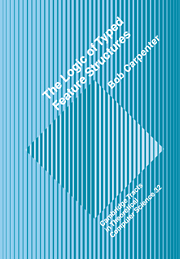 The Logic of Typed Feature Structures
The Logic of Typed Feature Structures 1 - Introduction
Published online by Cambridge University Press: 12 October 2009
Summary
In this monograph we motivate and provide theoretical foundations for the specification and implementation of systems employing data structures which have come to be known as feature structures. Feature structures provide a record like data structure for representing partial information that can be expressed in terms of features or attributes and their values. Feature structures are inherently associative in nature, with features interpreted as associative connections between domain objects. This leads to natural graph-based representations in which the value of a feature or attribute in a feature structure is either undefined or another feature structure. Under our approach, feature structures are ideally suited for use in unification-based formalisms, in which unification, at its most basic level, is simply an operation that simultaneously determines the consistency of two pieces of partial information and, if they are consistent, combines them into a single result. The standard application of unification is to efficient hierarchical pattern matching, a basic operation which has applications to a broad range of knowledge representation and automated reasoning tasks.
Our notion of feature structures, as well as its implications for processing, should be of interest to anyone interested in the behavior of systems that employ features, roles, attributes, or slots with structured fillers or values. We provide a degree of abstraction away from concrete feature structures by employing a general attribute-value logic. We extend the usual attribute-value logic of Rounds and Kasper (1986, Kasper and Rounds 1986) to allow for path inequations, but do not allow general negation or implication of the sort studied by Johnson (1987, 1988), Smolka (1988), or King (1989).
- Type
- Chapter
- Information
- The Logic of Typed Feature StructuresWith Applications to Unification Grammars, Logic Programs and Constraint Resolution, pp. 1 - 8Publisher: Cambridge University PressPrint publication year: 1992
